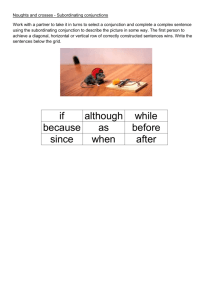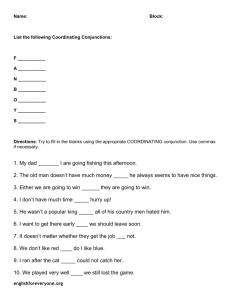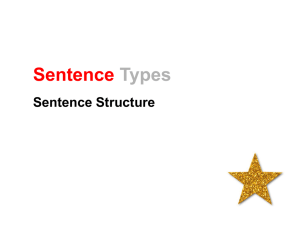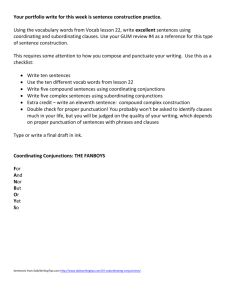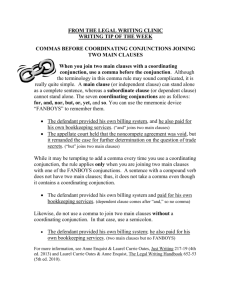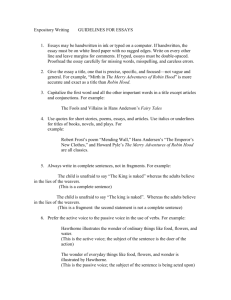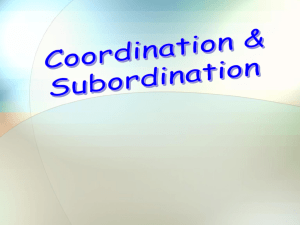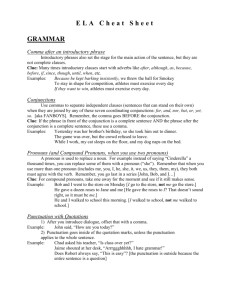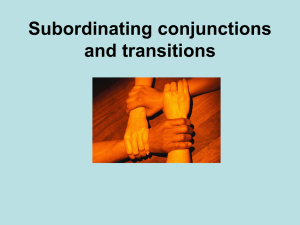fanboys pp - WordPress.com
advertisement
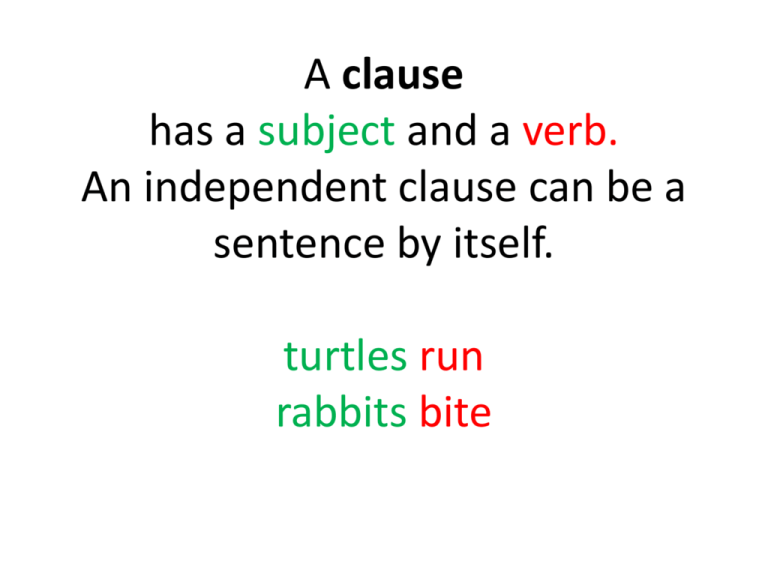
A clause has a subject and a verb. An independent clause can be a sentence by itself. turtles run rabbits bite Separate independent clauses with • A period and capital letter (Turtles run. Rabbits bite.) • A semicolon (Turtles run; rabbits bite.) • a comma and a coordinating conjunction (Turtles run, but rabbits bite. ) Coordinating conjunctions Connect two sentence elements of EQUAL WEIGHT (they separate two nouns, or two verbs, or two CLAUSES There are 7 coordinating conjunctions (MEMORIZE THESE!) for and nor but or yet so S V , cc S V Turtles run, but rabbits bite. OR S V cc V Turtles run and squeal. Two Patterns with Coordinating Conjunctions OR , cc coordinating conjunction S SUBJECT V VERB , and rabbits bite. S SUBJECT V VERB Turtles run Turtles run and squeal. SUBJECT S VERB V coordinating conjunction cc VERB V Which of these sentences requires a comma? • The situation was dire and caused trepidation. • The situation was dire and it caused trepidation. The situation was dire and caused trepidation. The situation was dire, and it caused trepidation. Danger! Beware these traps! • RUN-ON SENTENCE= The honey badger is fearless he will attack anything. (2 independent clauses without punctuation) • COMMA SPLICE= The honey badger is fearless, he will attack anything. ( 2 independent clauses separated by only a comma) Start a story with one sentence using one of the words or phrases below. Your sentence must contain at least twelve words. while when if only since as if after as long as that even if though although as though whenever once where in order that before whereas so that wherever if now that as unless than even though rather than until • Continue the story that is in front of you by writing ONE sentence. Your sentence must: have at least twelve words contain a word or phrase from the chart that YOU have not yet used and has not been used yet in the story in front of you contain a vocabulary word from your current list that YOU have not yet used and has not been used yet in the story in front of you. after that even if though while when if only since as if although as though whenever once where in order that before whereas so that wherever if now that as unless than even though rather than until as long as COMMON SUBORDINATING CONJUNCTIONS after as long as that even if though while when if only since as if although as though whenever once where in order that before whereas so that wherever if now that as unless than even though rather than until PUNCTUATION AND SUBORDINATING CONJUNCTIONS • DO NOT USE A COMMA when a subordinating conjunction is in between two clauses. • When a subordinating conjunction is at the beginning of a sentence, place a comma between the two clauses. • Turtles run where the grass is purple. • Where the grass is purple, turtles run free. 2 sentence patterns with subordinating conjunctions • DO NOT USE A COMMA when a subordinating conjunction is between two clauses. S V sc Turtles run where the S V grass is purple. • When a subordinating conjunction is at the beginning of a sentence, place a comma between the two clauses. sc Where the S V grass is purple , S V turtles run free. PRACTICE • Subordinating Conjunctions • Little, Brown Handbook page 173 WHERE DO THE COMMAS GO? • Write the vocabulary sentences meticulously for we will be using them later! • In order to increase her serenity she took a circuitous walk around the park. • The employees abominated Scrooge for he was miserly. WHERE DO THE COMMAS GO? • Because the problem was ponderous it engrossed him completely. • Although the temple was sacrosanct Indiana Jones ferreted out the treasure. • She will disclose the secret or she will remain discreet. WHERE DO THE COMMAS GO? • The beginning of class was not auspicious but the unimpeachable behavior of the students made it end well. • The benefactor gave students personal heaters and combed their hair. • He thought his reputation was immaculate but then he was indicted.
